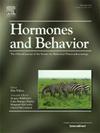一个超级基因影响了一种具有不同生殖形态的鸟类早期发育过程中的雄激素浓度。
IF 2.5
3区 医学
Q2 BEHAVIORAL SCIENCES
引用次数: 0
摘要
具有不同生殖策略的物种通常会在雌雄之间和雌雄内部表现出明显的表型差异。在某些物种中,这种变异最终会形成由基因决定的离散生殖形态,从而有助于研究基因变异如何转化为表型变异。在围脖(Calidris pugnax)中,常染色体反转多态性是三种生殖形态(独立型、卫星型和法德型)的基础,它们在成鸟体内的循环类固醇浓度不同。然而,类固醇浓度的形态差异是否在成年前就已出现,目前仍不得而知。我们研究了围脖雏鸟和幼鸟不同形态和性别间循环睾酮、雄烯二酮和孕酮浓度的差异,并将其与成年鸟的差异进行了比较。由于测量的激素浓度只能提供瞬时状态,而且在个体内部和个体之间存在很大差异,因此我们进行了重复测量,以比较组间的平均值、方差和偏度。我们发现,在生命早期,形态之间存在明显差异,但性别之间没有差异。在不同形态之间,幼年围脖的雄激素浓度在方差和偏度上存在差异,但在平均值上没有差异。在睾酮方面,"独立型 "的方差高于 "卫星型"/"长脚型",而在雄烯二酮方面,我们观察到了相反的模式。在孕酮方面,我们没有发现组间存在明显差异。偏度值反映了形态方差的差异。与成体相比,早熟围脖的雄激素浓度较低。在这两个生命阶段,我们都检测到了雄激素浓度与形态之间的特异性关联:与独立型相比,卫星型/长脚型的雄烯二酮浓度随睾酮浓度的增加而增加。这些观察到的生命早期的形态差异与雄性激素变异的超基因介导的调控是一致的,这种调控是成年行为表型多样化的基础。本文章由计算机程序翻译,如有差异,请以英文原文为准。
A supergene affects androgen concentrations during early development in a bird with alternative reproductive morphs
Species with alternative reproductive tactics typically show pronounced phenotypic variation between and within sexes. In some species, this variation culminates in discrete reproductive morphs that are genetically determined, facilitating studies on how genetic variation translates into phenotypic variation. In ruffs (Calidris pugnax), an autosomal inversion polymorphism underlies three reproductive morphs (Independents, Satellites and Faeders), which differ in circulating steroid concentrations in adults. Yet, it remains unknown whether morph differences in steroid concentrations already arise before adulthood. We examined variation in circulating testosterone, androstenedione and progesterone concentrations between morphs and sexes in ruff chicks and juveniles and compared the differences to those in adults. Since measured hormone concentrations only provide momentary states and show high within- and between-individual variation, we took repeated measurements to compare means, variances and skewness between groups. We found clear differences between morphs but not the sexes in early life. Between morphs, androgen concentrations in young ruffs differed in variance and skewness, but not in their means. For testosterone, Independents had a higher variance than Satellites/Faeders, whereas for androstenedione, we observed the opposite pattern. For progesterone, we did not detect clear differences between groups. Skewness values mirrored differences in morph variances. Compared to adults, premature ruffs had lower androgen concentrations. In both life stages, we detected morph-specific associations between androgen concentrations: androstenedione concentrations increased with testosterone concentrations more in Satellites/Faeders than in Independents. These observed morph differences during early life are consistent with a supergene-mediated regulation of androgen variation that underlies the diversification of adult behavioural phenotypes.
求助全文
通过发布文献求助,成功后即可免费获取论文全文。
去求助
来源期刊

Hormones and Behavior
医学-行为科学
CiteScore
6.70
自引率
8.60%
发文量
139
审稿时长
91 days
期刊介绍:
Hormones and Behavior publishes original research articles, reviews and special issues concerning hormone-brain-behavior relationships, broadly defined. The journal''s scope ranges from laboratory and field studies concerning neuroendocrine as well as endocrine mechanisms controlling the development or adult expression of behavior to studies concerning the environmental control and evolutionary significance of hormone-behavior relationships. The journal welcomes studies conducted on species ranging from invertebrates to mammals, including humans.
 求助内容:
求助内容: 应助结果提醒方式:
应助结果提醒方式:


